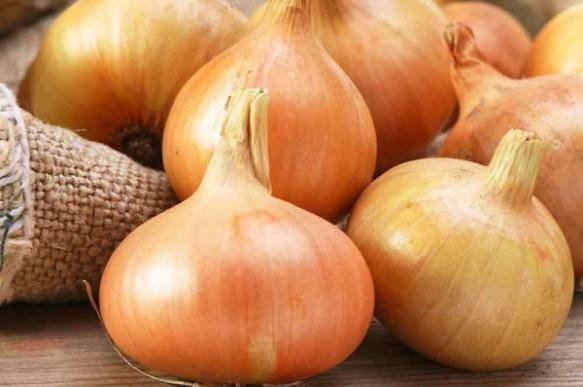- According to EastFruit, Ukrainian vegetable growers are experiencing serious problems with the sale of onion stocks from the 2020 harvest. It is quite obvious that these stocks will never be sold, and, in the near future, the onions will have to be trashed.
At the moment, there are still a lot of offers of last year’s onions on the market, which have been stored from August 2020 to the present day, manually sorted and calibrated. Ukrainian farmers are ready to sell such onions of almost perfect quality at 3-4 UAH/kg (11-15 US cents). Small onions of caliber 3-5 cost only about 1,5 UAH or less than 6 US cents per kg!
For comparison, at the same time in 2020 last year’s onions in Ukraine were sold at 11 UAH/kg, i.e. on average, 3-4 times more expensive, and in 2019 the prices at the end of the selling season reached 15 UAH/kg, and at the beginning of May 2019 a record wholesale selling price of onions for all years was set at 33 UAH/kg.
“Price cyclicality is common for the Ukrainian onion market. On average, once every three years, onions cost more during harvesting than in spring. Also, once every three years, a part of the onions not sold by Ukrainian vegetable growers should be disposed. The reason is that many small and medium farmers start growing onions when they become very expensive, which leads to an increase in supply. At the same time, almost no one in the country systematically exports onions, therefore, at the moment of onion overproduction, its prices fall below the production cost. After all, Ukrainian consumers will not buy more onions because they are cheap, and Ukrainian producers and exporters are not good at exporting them,” Andriy Yarmak explains.
The fact that the season of the early onion was delayed by a record this year did not make things better. Onions of the 2021 harvest are already on sale, but they cost 2-3 times more than last year’s. However, the demand for new onions is not that high either, as there are still a lot of last year’s products on the market.
“At the very beginning of the onion season last year, we already knew that Ukrainian producers would have problems with its sale. Therefore, our fruit and vegetable project offered its assistance in promoting the export of onions. However, there were almost no farmers willing to use this opportunity – they hoped that they would manage to sell their onions. Let’s be clear, the current price of onions in Ukraine does not cover the costs of production and harvesting, not to mention storing them for 9-10 months in expensive vegetable stores,” Andriy Yarmak says.
Onions are one of the best-selling types of vegetables on the global market and the global onion trade is growing dynamically. The global export of onion grows annually by $ 115 million and reaches almost $ 4 billion a year. The Netherlands is the leader in onion export in the world, which sells onions worth almost half a billion dollars annually to the countries of Sub-Saharan Africa! At the same time, Ukraine almost does not export onions there, as well as to the Middle East, which is also a major onion importer. We wrote about the prospects for exporting onions to Africa in the article “Is it possible to export onions and potatoes from Ukraine to Africa?”.
“In Ukraine, any onion-production project will be doomed to periodic large losses if it does not initially plan to export a significant part of its products. Even if prices on the domestic market turn out to be higher than in export markets, such a project should maintain contacts with buyers and sell part of the products for export. Only in this case one can say it is a sustainable vegetable business and development. After all, systematic constant export allows producers to better feel the situation on the market and respond to it faster, makes them produce better products, invest in refinement, improve quality and look for more effective business solutions. Additionally, export allows diversifying the risks of currency devaluation, which is important for Ukrainian businessmen. Accordingly, a farmer who has several options to sell high-quality products on the domestic market even in such difficult seasons as the current one, will manage to sell them at a good price”, FAO economist says.
By the way, Ukraine has significantly increased export of onions in the second half of the 2020/21 season. 11 thousand tons of Ukrainian onions were exported to foreign markets in January-March 2021, which is 40% more than a year earlier. Romania became the main sales market for onions from Ukraine, thanks to a very successful trade mission at the end of 2019, organized by the FAO and EBRD project in cooperation with the Ukrainian Horticultural Association (UHA). More than 53% of all onions were delivered here. However, the export of Ukrainian onions to Iraq decreased in 2021 by almost 4 times to 1.2 thousand tons. There were also Belarus, Turkey, Azerbaijan, Poland, Great Britain, Estonia, Bulgaria and the Czech Republic among the largest importers of onions from Ukraine. It is gratifying that such African countries as Cameroon and Sierra Leone have appeared on the map of Ukrainian onion export.
However, one should not forget that such exports are not systemic, as a rule. As soon as prices in the domestic market rise, producers forget about the need to diversify sales markets and stop responding to the requests of importers. This lasts until the next price collapse in the domestic market.
The use of the site materials is free if there is a direct and open for search engines hyperlink to a specific publication of the East-Fruit.com website.




